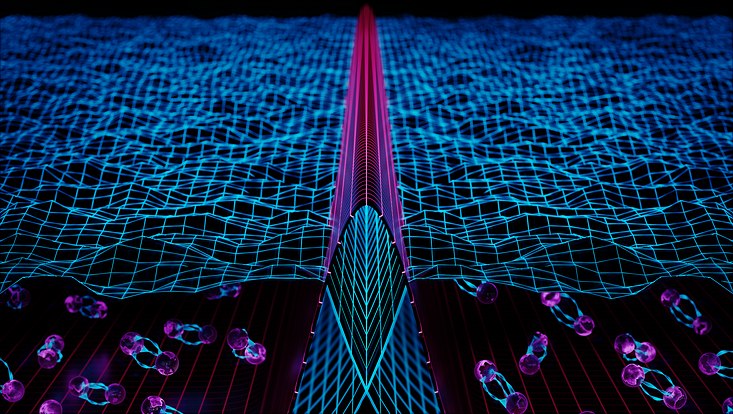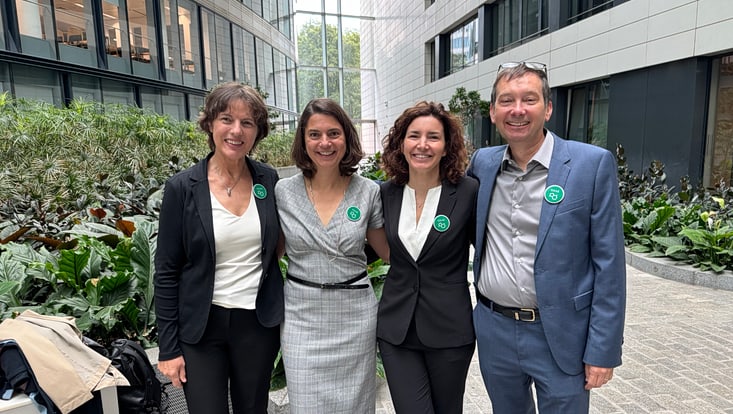Imaging of Matter
From the tunnel effect to quantum computers: Nobel Prize in Physics honors fundamental research in quantum mechanics
9 October 2025

Photo: Electron Studios, UHH, Moritz
In quantum physics, many events are random. Classical determinism does apply to other areas no longer apply here, and yet these concepts form the basis of modern technologies. The Royal Swedish Academy of Sciences has now awarded the Nobel Prize in Physics to three quantum researchers.
John Clarke from the University of California, Berkeley; Michel Devoret from Yale University and the University of California, Santa Barbara; and John Martinis, also from the University of California, Santa Barbara, received the prize “for the discovery of macroscopic quantum mechanical tunnelling and energy quantisation in an electric circuit.” Their experiments, conducted in the 1980s, formed the basis for the subsequent use of quantum phenomena in superconducting circuits and quantum bits. Prof. Henning Moritz, from the Institute of Quantum Physics and the Cluster of Excellence “CUI: Advanced Imaging of Matter”, explains the research and its significance for the field (see also: Tagesschau-Interview with Henning Moritz, 7.10.2025, in German).
Professor Moritz, could you please explain what quantum mechanical tunnelling is, and why it is so important that the three researchers have now been honored for its discovery?
From our everyday experience, we know that water cannot flow from a higher glass over the rim to a lower one. However, 100 years ago, Erwin Schrödinger postulated that the location of a single particle could not be described precisely, but rather by a probability distribution. With a certain probability, it could also be in another glass of water. The three prize winners performed their experiments with electrons rather than water. They observed that, figuratively speaking, all electrons can simultaneously flow into the next glass of water — that is, into the next potential minimum. This phenomenon is known as quantum mechanical tunnelling, and it occurs not only with particles, but also with macroscopic objects.
What are applications for this research?
The tunnel effect itself has many applications, ranging from scanning tunnelling microscopes to highly precise magnetic field measurements. The particular importance of the research of the Nobel Prize winners is that it has led to the realization of quantum computers over the last 10 years, which promise much higher computing power than classical computers. These could for example be used to find new catalysts for energy storage or new active substances curing diseases more quickly.
You mentioned quantum computers. How do they differ from conventional computers?
Conventional computers work with zeros and ones. However, the quantum bits of a quantum computer can not only be zero or one but also both simultaneously. This superposition state can lean more toward zero or more towards one, and a great deal of information for computing can be stored with this ratio. When performing a computational operation between two qubits, all possible options are calculated n parallel. With just 300 quantum bits, more calculations can be performed in parallel in a single operation than there are atoms in the universe. Each additional quantum bit in a quantum computer doubles its capacity, whereas an additional bit in a classical computer makes very little difference. The supremacy of quantum computers over classical computers has not yet been shown for useful problems, but enormous progress has been made.
How important is the Nobel Prize for this research?
In my view, it is very important because it honors the fundamental research that has paved the way for this anticipated revolution in information technology. It recognizes the fundamental and visionary research that may not have aimed to quickly calculate a catalyst or find active substances, but may make this possible soon. The award clearly recognizes that macroscopic quantum mechanical tunnelling was one of the first key experiments on the road to superconducting quantum computers.
How far along is the research in the cluster?
Several research groups in the AIM cluster are performing research on quantum computing with neutral atoms. This approach has developed extremely rapidly in recent years, surpassing the aforementioned superconducting quantum computers in many parameters, despite being a much more recent development and having not yet received billions in investment from large tech companies such as Google and IBM. This is now changing rapidly, setting the stage for an exciting race.
Find out more about
the tunnel effect and how important it is for transporting electricity without resistance,
exploring superfluidity with quantum gases (experimental physicist Dr. César Cabrera Córdova has received a €1.9 million ERC Starting Grant to do so),
the extension of the Cluster of Excellence (including videos by Cluster spokespersons Prof. Francesca Calegari and Prof. Henry Chapman).


